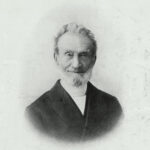Matthew’s Gospel was the first Bible book I studied in depth. It’s where I learned to understand context, follow cross references, and appreciate biblical theology. I marveled at the way Matthew shows his audience that Jesus is Israel’s promised Messiah. Roughly 20 times he says something like, “This was to fulfill what was spoken through the prophet” (Matt. 1:22–23; 2:5–6; and so on). It’s like he’s pointing to Jesus, saying: “Look! God has kept his promise!”
Most of Matthew’s prophetic references are straightforward, but not all are. One of the most perplexing surrounds the virgin birth of Jesus in Matthew 1:21–23:
She will bear a son, and you shall call his name Jesus, for he will save his people from their sins. All this took place to fulfill what the Lord had spoken by the prophet: “Behold, the virgin shall conceive and bear a son, and they shall call his name Immanuel” (which means, God with us).
A quick look at the cross-reference reveals that Matthew is quoting Isaiah 7:14. But when we turn to Isaiah 7, it sure doesn’t sound like Isaiah is preparing his readers to anticipate the Messiah coming through a virgin birth.
What Does Isaiah 7 Promise?
Isaiah 7 introduces us to a wicked king of Judah named Ahaz, who had forsaken his father’s legacy and led the nation into idolatry. Ahaz’s wicked reign was threatened by an alliance of two kings: Rezin (king of Syria) and Pekah (king of Israel). Rather than cry to God for help, Ahaz turned to the Assyrian king Tiglath-Pileser. Isaiah was sent by God to tell Ahaz that he would deliver Israel and that he should ask God for a sign to confirm his promise.
When we turn to Isaiah 7, it sure doesn’t sound like Isaiah is preparing his readers to anticipate the Messiah coming through a virgin birth.
Ahaz didn’t want God’s help, so he declined the offer. He was attempting to appear humble, but it’s not humble to disobey what God commands. But God gave him a sign anyway, and the sign wasn’t just for him; it was also for the entire nation.
Hear then, O house of David! Is it too little for you to weary men, that you weary my God also? Therefore the LORD himself will give you [plural] a sign. Behold, the virgin shall conceive and bear a son, and shall call his name Immanuel. He shall eat curds and honey when he knows how to refuse the evil and choose the good. For before the boy knows how to refuse the evil and choose the good, the land whose two kings you dread will be deserted. (Isa. 7:13–16)
This child would serve as a “sign” to Ahaz and the nation. Before this child was old enough to discern between good and evil, both Rezin and Pekah would be gone. This child would be proof that God was present among his people to protect them. They could trust that neither Ahaz nor Pekah nor Rezin nor Tiglath-Pileser nor any other oppressor would be able to ultimately destroy God’s people. God would preserve Judah and David’s line through whom Messiah would one day come.
How Is Isaiah 7 Fulfilled?
In a classic Sesame Street episode, the friendly blue character Grover teaches kids the difference between “near” and “far.” He begins close to the camera saying “near,” and then runs away yelling “far.” His lesson is helpful to learn basic orientation—as well as how to read prophecy. Prophecies often have a near (partial) fulfillment that applies directly to their hearers as well as a far (ultimate) fulfillment related directly to Jesus.
This is the case in Isaiah 7. The near (partial) fulfillment of Isaiah’s prophecy is debated. Isaiah never clearly tells us how God fulfilled the prophecy, which leaves us guessing between at least four possibilities.
- Some think righteous King Hezekiah would be a sign of God’s faithful presence. But he would’ve likely already been born when this prophecy was given.
- Some speculate that an unnamed child born to an unknown virgin fulfilled the promise. This is possible, but if the woman was unknown to both Ahaz and Isaiah, then her child wouldn’t be much of a sign.
- Some argue that no immediate fulfillment came in Ahaz’s day and that Jesus is the only fulfillment. But this seems nearly impossible, because the sign was said to be for Ahaz, and he’d be long dead before Jesus showed up.
- Some argue that Isaiah’s son Maher-shalal-hash-baz is the near fulfillment (Isa. 8:1–4). In favor of this view is the similarity in language between Isaiah 7:14–15 and Isaiah 8:3–4, the child’s birth is called a sign (Isa. 8:18), and the fact that he once again references Immanuel (Isa. 8:8). Against this view is the fact that if the prophetess is Isaiah’s wife, then they already had a child together (Isa. 7:3). This means she would not have been a virgin, though she may still have been a young woman (more on this in a moment).
Though not certain, I lean toward the fourth option as the least problematic.
Prophecies often have a near (partial) fulfillment that applies most directly to their hearers as well as a far (ultimate) fulfillment related directly to Jesus.
But regardless of your conclusion, it doesn’t change Matthew’s use of the prophecy because the Holy Spirit assures us that the far (ultimate) fulfillment of Isaiah 7 is found in the virgin birth of Jesus. Mary was the foretold virgin through whom God gave Jesus as the sign proving that he would be with his people to save them.
The word translated “virgin” in Isaiah 7:14 is ’almah, which can simply mean “young woman” depending on context. Yet interestingly, Matthew (following the Greek Septuagint) used the word parthenos, which can only mean “virgin.” Thus, Matthew’s testimony of Jesus’s miraculous conception followed a faithful Jewish interpretation of Isaiah’s prophecy.
Why Does This Matter?
First, it matters because we can trust Matthew’s interpretation. Matthew isn’t just searching for vaguely matching verses in the Old Testament and then projecting the virgin birth of Christ onto Isaiah’s prophecy. Rather, before there was a Christian doctrine of a virgin birth resulting in “God with us,” there was a Jewish doctrine of a virgin birth resulting in “God with us.”
Before there was a Christian doctrine of a virgin birth resulting in ‘God with us,’ there was a Jewish doctrine of a virgin birth resulting in ‘God with us.’
Matthew is telling us that Isaiah, whether he knew it or not (cf. 1 Pet. 1:12), was speaking of the Messiah—and that his prophecy is fulfilled, completed, accomplished, and realized in the miraculous conception of Jesus. We can trust Matthew’s interpretation of Isaiah 7 because his writings are inspired by the same Spirit who inspired Isaiah’s prophecy.
Second, it matters because we can trust God’s promises. What God promised about a Messiah to Adam (Gen. 3:15), Abraham (Gen. 12:7; 13:15; 24:7), Judah (Gen. 49:10), and David (2 Sam. 7:12–15) rests on what he promises to Isaiah. The incarnation of God’s Son is a sign to the world that God hasn’t forsaken his people. He has kept his promises, just as he always does. Joseph was to find comfort in the fact that Mary hadn’t been unfaithful to him, but God had been faithful to his people by coming among them through Jesus.
In the same way, we should see Jesus as God’s sign to the world promising that we will escape the coming judgment and inherit salvation if we will trust in him. The provision of God’s presence is the greatest of graces. It’s our hope through Christ both now and forever when we shall “see his face” (Rev. 22:4).
Lord, hasten to be “with us” fully and finally.
Is there enough evidence for us to believe the Gospels?
 In an age of faith deconstruction and skepticism about the Bible’s authority, it’s common to hear claims that the Gospels are unreliable propaganda. And if the Gospels are shown to be historically unreliable, the whole foundation of Christianity begins to crumble.
In an age of faith deconstruction and skepticism about the Bible’s authority, it’s common to hear claims that the Gospels are unreliable propaganda. And if the Gospels are shown to be historically unreliable, the whole foundation of Christianity begins to crumble.



































